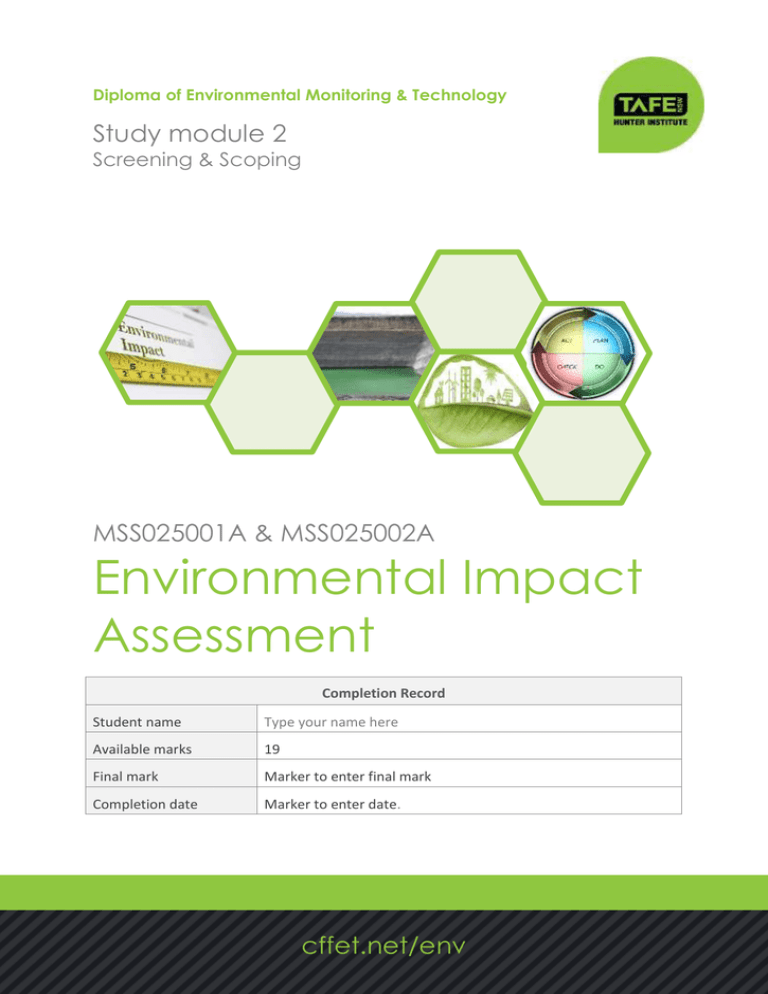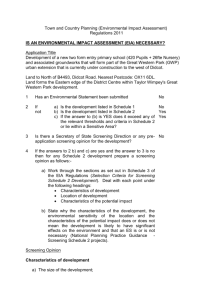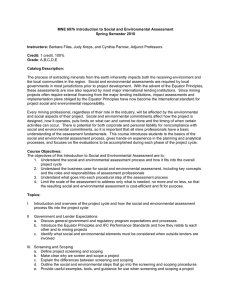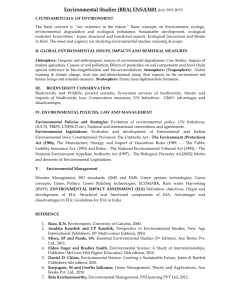Environmental Impact Assessment Study module 2
advertisement

Diploma of Environmental Monitoring & Technology Study module 2 Screening & Scoping MSS025001A & MSS025002A Environmental Impact Assessment Completion Record Student name Type your name here Available marks 19 Final mark Marker to enter final mark Completion date Marker to enter date. cffet.net/env EIA Study module 2 Screening & Scoping INTRODUCTION 2 PRESCRIPTIVE SCREENING 4 Section 149 Planning Certificates Prescriptive EPI’s Discretionary screening 4 5 8 CRITERIA FOR THE DISCRETIONAL EIA 9 Character of the receiving environment Potential impact of proposal Resilience of natural and human environments to cope with change Confidence of prediction of impacts Presence of planning, policy framework and other decision-making processes Degree of public interest 9 10 10 11 11 11 STATEMENT OF ENVIRONMENTAL EFFECTS 12 Statement of Environmental Effects 12 SCOPING 13 Purpose of scoping Approaches to scoping EIA Terms of Reference 13 15 15 ASSESSMENT TASK 17 Assessment & submission rules References & resources Acknowledgement Chemical, Forensic, Food & Environmental Technology [cffet.net] Version 1.0 30/05/2016 20 20 21 Page | 1 EIA Study module 2 Screening & Scoping Introduction As discovered in the first study module, the EIA process is quite complex and varied. This complexity is made more difficult to understand by the various forms of EPI and legislative requirements that exist, made even more difficult considering that every State and Territory has a different planning system to NSW. This Study Module looks at two separate processes that generate a lot of focus for the proponent of a development application, namely the screening and scoping processes. In every other text you read on EIA, these two processes will be written as separate sections, but as our focus will be on impact assessment techniques, it is condensed for convenience and expedience. This section introduces the different procedures and methods for identifying whether or not an EIA is required for a proposal. Screening is the first key decision of the EIA process, the purpose of which is to determine whether a proposal requires an EIA or not. It is intended to ensure that the form or level of any EIA review is equal to the importance of the issues raised by any proposed development. Some type of screening procedure is necessary because of the large number of projects and activities that are potentially subject to EIA. Screening involves making a preliminary determination of the expected impact of a proposal on the environment and of its relative significance. A certain level of basic information about the proposal and its location is required for this purpose. Most proposals can be screened very quickly (in an hour or less) but some will take longer and a few will require an extended screening or initial assessment. Similarly, the majority of proposals may have few or no impacts and will be screened out of the EIA process. A smaller number of proposals will require further assessment. Only a limited number of proposals, usually major projects, will warrant a full EIA because they are known or considered to have potentially significant adverse impacts on the environment, examples of which could include impacts on; ◗ human health and safety ◗ rare or endangered species ◗ protected areas, fragile or valued ecosystems and biological diversity ◗ air, soil and water quality ◗ lifestyle and livelihood of local communities Chemical, Forensic, Food & Environmental Technology [cffet.net] Version 1.0 30/05/2016 Page | 2 EIA Study module 2 Screening & Scoping The screening process can have one of four outcomes: ◗ no further level of EIA is required ◗ a full and comprehensive EIA is required ◗ a more limited EIA is required ◗ further study is necessary to determine the level of EIA required Screening also can help provide the basis for the scoping process, which identifies the key impacts to be studied and establishes terms of reference for an EIA. On occasion, the screening and scoping stages may overlap, for example, when a further study is undertaken to determine whether or not the potential impacts are significant enough to warrant a full EIA. This leads to an important point about the structure of these notes; The requirements for screening and the procedure to be followed are often defined in the applicable EIA law or regulations. In many cases, the proposals to which EIA applies are listed in an annex, or in the case of NSW laws, the various Schedules and Environmental Planning Instruments (EPIs). The proponent is given the responsibility for carrying out screening, but whatever the requirements, screening occurs as early as possible in the development of the proposal so that the proponent and other participants are aware of the EIA obligations. The screening procedures employed for this purpose can be classified into two broad, overlapping approaches: ◗ prescriptive screening (i.e. subject to or exempt from as defined or listed in EPIs, legislation and regulations) ◗ discretionary screening (i.e. subject to impact determination through assessment) Both prescriptive and discretionary approaches have a place and their specific procedures can be combined into a comprehensive procedure. As such some proposals will be on the borderline in relation to a listed threshold and for others, the environmental impacts may be unclear or uncertain. In these situations, the discretionary screening should be undertaken, applying any indicative guidelines and criteria established for this purpose (for which there are many tools and techniques). This process gives the proponent or competent authority greater discretion than mandatory lists in determining the requirement for EIA. In NSW… We typically use both techniques in NSW planning. We can start with prescriptive screening through a Section 149 Planning Certificate, and can finish with the consent authority requesting a discretionary type of screening! Chemical, Forensic, Food & Environmental Technology [cffet.net] Version 1.0 30/05/2016 Page | 3 EIA Study module 2 Screening & Scoping In this context, screening is a flexible process and can be extended into preliminary forms of EIA study, including reports such as Initial Environmental Examination (IEE) or a Statement of Environmental Effects (SEE), which are carried out with most developments in the initial submission. Prescriptive screening Consider a development for a company that owns the land on which it wants to develop. All land has to sit within a Local Government Area (LGA, i.e. a local council). So the first step could be to approach the Council for information, which comes in the form of a Section 149 planning certificate. Section 149 Planning Certificates These Certificates will typically outline the names of the relevant Environmental Planning Instruments (EPI’s) that apply to the land being developed, and then outline the relevant planning considerations under the Councils Local Environment Plan (LEP), for example; Names of relevant planning instruments and DCP’s The name of the LEP that land is controlled under, for example; ◗ Fairfield Local Environmental plan 2013 The EPIs that apply to the land, for example; ◗ SEPP No. 1 – Development Standards ◗ SEPP No. 4 – Development without consent… ◗ SEPP (Major Development) 2005 ◗ SEPP No. 50 – Canal Development ◗ SEPP no. 19 – Bushland in urban Areas ◗ SEPP (State and Regional Development) 2011 Zoning and land use under relevant LEP The identity of zone, for example; ◗ IN1 – General Industrial Development permitted without consent, for example; ◗ Environmental protection works Development permitted only with development consent, for example; Depots; Freight transport facilities; Funeral homes; Garden centres; General industries; Chemical, Forensic, Food & Environmental Technology [cffet.net] Version 1.0 30/05/2016 Page | 4 EIA Study module 2 Screening & Scoping Hardware and building supplies; Industrial training facilities; Kiosks; Landscaping material supplies; Light industries; Neighbourhood shops; Plant nurseries; Roads; Rural supplies; Take away food and drink premises; Timber yards; Vehicle sales or hire premises; Warehouse or distribution centers. Development that is prohibited, for example; ◗ Air transport facilities, Water recreation structures, Correctional centers etc. Air transport facilities; Airstrips; Amusement centres; Boat launching ramps; Boat sheds; Camping grounds; Caravan parks; Cemeteries; Charter and tourism boating facilities; Commercial premises; Correctional centres; Eco-tourist facilities; Entertainment facilities; Environmental facilities; Exhibition homes; Exhibition villages; Extensive agriculture; Farm buildings; Forestry; Function centres; Health consulting rooms; Heavy industrial storage establishments; Heavy industries; Home-based child care; Home businesses; Home occupations; Home occupations (sex services); Information and education facilities; Intensive livestock agriculture; Jetties; Marinas; Medical centres; Mooring pens; Moorings; Research stations; Residential accommodation; Restricted premises; Rural industries; Sex As you can see, the Planning Certificate provides a great amount of detail as to what EPIs apply to the land, but it also details which aspects of the LEP are triggered by the proposed development and to an extent, explains why. But a Planning Certificate may not tell the whole story, as there may be complicating or overlapping SEPPs or certain Commonwealth complexities. Prescriptive EPI’s Now the developer knows which EPI’s apply to the land, they must go through each EPI to examine the specifics of the instrument (or hire someone to do it for them). Consider the SEPP 55. If this SEPP applies to the land on which the development occurs, then the details of the SEPP must be considered. The snippet below is from the SEPP 55. Figure 2.1 – Snippet of SEPP 55 – Remediation of Land Chemical, Forensic, Food & Environmental Technology [cffet.net] Version 1.0 30/05/2016 Page | 5 EIA Study module 2 Screening & Scoping Project lists for screening Project lists are widely used to screen proposals, of which there are two types; inclusive and exclusive. Most are inclusion lists, which describe the project types and size thresholds that are known or considered to have significant or serious environmental impacts. In NSW legislation the equivalent to a project list can be found as ‘Schedules’ in legislation Usually, listed projects that fall within these predetermined thresholds will be subject automatically to full and comprehensive EIA. Some EIA systems also maintain exclusion lists of activities that are exempt because they are known to have little or no environmental impact. In certain EIA systems, scale thresholds are specified for each type of listed project for which an EIA is mandatory. Other projects that may require an EIA are screened individually against environmental significance criteria, such as emission levels or proximity to sensitive and protected areas. Results of screening Once the prescriptive process is complete, the developer has a list of all the statutory triggers that require attention. An example of this has been provided below, which is from a development application for an extension to a mine; Figure 2.2 – Summary of triggered legislation from a coal mine environmental assessment. Chemical, Forensic, Food & Environmental Technology [cffet.net] Version 1.0 30/05/2016 Page | 6 EIA Study module 2 Screening & Scoping Figure 2.3 – Summary of the EPI’s triggered by the same mine Other legislation that the mine needed to consider included (but not limited to); ◗ Mining Act 1992 ◗ Coal Mine Health & Safety Act 2002 ◗ Protection of Environment Operations Act 1997 ◗ Water management Act 2000 ◗ Water Act 1912 ◗ Environmentally hazardous Chemicals Act 1985 Chemical, Forensic, Food & Environmental Technology [cffet.net] Version 1.0 30/05/2016 Page | 7 EIA Study module 2 Screening & Scoping Discretionary screening The process of prescriptive screening is the result of a statutory evolution which has resulted in the NSW legislation being quite adept at determining the need for assessment. In short, there are many triggers for many different types of land use, development and environment types, so most environmental concerns are ‘captured’ when the prescriptive process is applied in NSW. But what happens when the consent authority encounters a development, or specific parts of a development that don’t trigger EPI’s yet still cause concern for the consent authority? Cases such as these do occur, and discretionary screening is the process that fills this gap. Discretionary screening is the method used when the significance of the potential environmental impact of a proposal is unclear or uncertain. This process also applies to proposals that fall just below or close to the thresholds established for listed projects. In addition, non-borderline proposals may be subject to discretionary screening if they are located in sensitive areas or there is a potential for cumulative effects in combination with other current and foreseeable activities. The framework contains a sieve of screening applications with a progressively finer mesh for including proposals. It has gained a degree of international acceptance as a standard of good practice. Typically, the criteria used are based on a number of common factors related to the consideration of the significance of environmental impacts. These include the location of proposals, environmental sensitivity and any likely health and social effects on the local population. These criteria may be adapted to wider use in case-by-case screening. A proposal can be tested for significance by taking account of: ◗ location near to protected or designated areas or within landscapes of special heritage value ◗ existing land use(s) and commitments ◗ the relative abundance, quality and regenerative capacity of natural resources ◗ the absorption capacity of the natural environment, paying particular attention to wetlands, coastal zones, mountain and forest areas ◗ areas in which the environmental quality standards laid down in law have been exceeded already Chemical, Forensic, Food & Environmental Technology [cffet.net] Version 1.0 30/05/2016 Page | 8 EIA Study module 2 Screening & Scoping Using the emphasised aspects above, consideration can be given to sustainability criteria when carrying out case-by-case screening. However, this approach demands considerable information about the environment, which is unlikely to be available at a relatively early stage in project development. In these circumstances, only a qualified determination of the environmental significance of a proposal may be possible and screening decisions must be open to change if new information indicates the advisability of reclassification. Certain proposals may be subject to an extended screening or initial assessment. Such an approach can be used when the requirement for EIA could not be reasonably determined by the application of the prescriptive screening procedures. When undertaking this type of preliminary EIA study, the proponent or competent authority may need to assemble considerable information. This is accompanied by a framework of criteria and questions that can help in the conduct of a preliminary EIA. Information that may be required for a preliminary EIA study includes; ◗ a description of the proposal ◗ applicable policies, plans and regulations, including environmental standards and objectives ◗ the characteristics of the environment, including land use, significant resources, critical ecological functions, pollution and emission levels etc ◗ the potential impacts of the proposal and their likely significance ◗ the degree of public concern and interest about the proposal Criteria for the discretional EIA This is a somewhat ‘old school’ approach and is based on the ANZECC Guidelines and Criteria for Determining the Need for and level of Environmental Impact Assessment in Australia (1996). This document has since been superseded by many other documents but the essence is the same. Character of the receiving environment Consider: ◗ Is it, or is it likely to be, part of the conservation estate or subject to treaty? ◗ Is it an existing or potential environmentally significant area? ◗ Is it vulnerable to major natural or induced hazards? ◗ Is it a special purpose area? ◗ Is it an area where human communities are vulnerable? Chemical, Forensic, Food & Environmental Technology [cffet.net] Version 1.0 30/05/2016 Page | 9 EIA Study module 2 Screening & Scoping ◗ Does it involve a renewable or a non-renewable resource? ◗ Is it a degraded area, subject to significant risk levels, or a potentially contaminated site? Note… Off-site (out of area) as well as on-site (local) characteristics should be considered, where relevant, and incorporated into decision making processes. Potential impact of proposal Consider: ◗ Will implementation or construction, operation and/or decommissioning of the proposal have the potential to cause significant changes to the receiving environment (on-site or off-site, transboundary, short term or long term)? ◗ Could implementation of the proposal give rise to health impacts or unsafe conditions? ◗ Will the proposal significantly divert resources to the detriment of other natural and human communities? Note… This should include consideration of the magnitude of the impacts, their spatial extent, the duration and the intensity of change, the total life cycle and whether and how the impacts are manageable. Resilience of natural and human environments to cope with change Consider: ◗ Can the receiving environment absorb the level of impact predicted without suffering irreversible change? ◗ What are the implications of the proposal for bio-diversity? ◗ Can land uses at and around the site be sustained? ◗ Can sustainable uses of the site be achieved beyond the life of the proposal? ◗ Are contingency or emergency plans proposed or in place to deal with accidental events? Chemical, Forensic, Food & Environmental Technology [cffet.net] Version 1.0 30/05/2016 Page | 10 EIA Study module 2 Screening & Scoping Note… Cumulative as well as individual impacts should be considered in the context of sustainability. Confidence of prediction of impacts Consider: ◗ What level of knowledge do we have on the resilience of a given significant ecosystem? ◗ Is the proposal sufficiently detailed and understood to enable the impacts to be established? ◗ Is the level and nature of change to the natural human environment sufficiently understood to allow the impact of the proposal to be predicted and managed? ◗ Is it practicable to monitor the predicted effects? ◗ Are present community values on land use and resource use known or likely to change? Presence of planning, policy framework and other decisionmaking processes Consider: ◗ Is the proposal consistent with existing policy frameworks? ◗ Do other approval processes exist to adequately assess and manage proposal impacts? ◗ What legislation, standard codes or guidelines are available to properly monitor and control operations and the types or quantity of the impacts? Degree of public interest Consider: ◗ Is the proposal controversial or could it lead to controversy or concern in the community? ◗ Will the amenity, values or lifestyle of the community be adversely affected? ◗ Will large numbers of people require relocation? ◗ Will the proposal result in inequities between sectors of the community? Chemical, Forensic, Food & Environmental Technology [cffet.net] Version 1.0 30/05/2016 Page | 11 EIA Study module 2 Screening & Scoping Statement of Environmental Effects In some EIA systems, an initial environmental evaluation (IEE) is required when the potential environmental impacts of a proposal cannot be established by the application of standard screening procedures. Typically, an IEE is a relatively low-cost analysis that makes use of information already available. It is carried out using EIA procedures and methods, which are scaled to purpose. A site or area visit should take place to survey the current situation and obtain baseline information. Simple methods, such as a checklist or matrix, are used in impact identification and often focus on appropriate mitigation measures. Depending on its findings, the IEE report can be used either as a scoping document when a proposal is referred to a full EIA or to support environmentally sound planning and design when a proposal does not require further review. An IEE is a preliminary EIA study that: ◗ describes the proposal and the environmental setting ◗ considers alternatives to improve the environmental benefits ◗ addresses the concerns of the local community ◗ identifies the potential environmental effects ◗ identifies measures to mitigate adverse impacts; ◗ describes, as necessary, environmental monitoring and management plans Statement of Environmental Effects In the NSW, a Statement of Environmental Effects (SEE) is required for all development applications (DA) except for designated development (which requires EIS). The size of the SEE will therefore vary according to the proposed development and its potential to impact on the natural and built environments. What does a SEE cover? Under Section 79C of the EP&A Act, there are a variety of matters that the SEE must cover, and includes the triggers of EPI’s, Develop Control Plans (DCPs), the likely impacts, suitability and public interest. A Statement of Environmental Effects (SEE) outlines: ◗ the likely environmental impacts of the development ◗ how the environmental impacts of the development have been identified ◗ the steps that will be taken to protect or mitigate damage to the environment The amount of information required will depend on the type and scale of your application and will include: Chemical, Forensic, Food & Environmental Technology [cffet.net] Version 1.0 30/05/2016 Page | 12 EIA Study module 2 Screening & Scoping ◗ A description of the site and surrounding locality ◗ Present and previous uses of the site ◗ Existing structures on the land ◗ A detailed description of the proposal ◗ Operational and management details ◗ Reference to any environmental planning instruments and applicable zoning ◗ Reference to any development control plans that are applicable Because a SEE covers both the prescriptive screening, and essentially covers discretionary screening by examining the potential impacts of the development, a SEE is difficult to classify as a discrete screening or scoping tool – it does both. Scoping On successful completion of this Section, you will be able to: ◗ Understand and explain why scoping is necessary in EIA ◗ Know how to undertake scoping, including knowledge of different methods and approaches ◗ Be able to articulate the scoping process to stakeholders Purpose of scoping The scoping process identifies the issues that are likely to be of most importance during the EIA and eliminates those that are of little concern. Typically, this process concludes with the establishment of Terms of Reference for the preparation of an EIA. In this way, scoping ensures that EIA studies are focused on the significant effects and time and money are not wasted on unnecessary investigations. Scoping refers to the open and interactive process of determining the major issues and impacts that will be important in decision-making on the proposal, and need to be addressed in an EIA. Public involvement is usually an integral part of the scoping process. Public input helps to ensure that important issues are not overlooked when preparing Terms of Reference and/or initiating the EIA study. Chemical, Forensic, Food & Environmental Technology [cffet.net] Version 1.0 30/05/2016 Page | 13 EIA Study module 2 Screening & Scoping A detailed analysis as to the purpose of scoping shows the need to identify: ◗ the important issues to be considered in an EIA ◗ the appropriate time and space boundaries of the EIA study ◗ the information necessary for decision-making ◗ the significant effects and factors to be studied in detail ◗ Discover feasible alternatives, or prove no alternatives exist Typically, scoping begins after the completion of the screening process. However, these stages may overlap to some degree (see SEE). Essentially, scoping takes forward the preliminary determination of significance made in screening to the next stage of resolution determining which issues and impacts are significant and require further study. In doing so, the scoping process places limits on the information to be gathered and analysed in an EIA and focuses the approach to be taken. Scoping is completed when the detailed studies required in the EIA have been specified often this involves preparing Terms of Reference (ToR) or an equivalent document. This document sets out what the EIA is to cover, the type of information to be submitted and the depth of analysis that is required. It provides guidance to the proponent on how the study should be conducted and managed. The scoping process itself can vary in scale, complexity and time. A comprehensive approach to scoping may be needed for large-scale proposals, which have a range of impacts that are potentially significant. In other cases, scoping will be a more limited and restricted exercise. Depending on the circumstances, the scoping process can be tailored to include some or all of the aims listed below. Key objectives of scoping are to: ◗ inform the public about the proposal ◗ identify the main stakeholders and their concerns and values ◗ find or reject any reasonable and practical alternatives to the proposal ◗ focus the important issues and significant impacts to be addressed by an EIA ◗ define the boundaries for an EIA in time, space and content ◗ set requirements for the collection of baseline data ◗ establish the Terms of Reference Chemical, Forensic, Food & Environmental Technology [cffet.net] Version 1.0 30/05/2016 Page | 14 EIA Study module 2 Screening & Scoping Approaches to scoping A systematic and transparent approach should be taken to sifting the concerns, issues and impacts. This can be undertaken in three steps: The long list Compile a long list of concerns from the information available and the inputs of stakeholders. No attempt should be made at this stage to exclude or pre-judge concerns. The short list Derive a short list of key issues and problem areas based on their potential significance and likely importance for decision-making on the proposal. This phase involves evaluating the issues against selected criteria; for example, differentiating serious risks or threats from effects that can be mitigated. The classification Classify and order the key issues into impact categories by reference to policy objectives and scientific concepts, such as emission levels that may exceed health or environmental standards. Ultimately, the scoping begins by preparing a profile of the scope under key headings and using this as a basis for informal consultations with key stakeholders. Once this round of discussion has occurred, the three steps described above take place with iterations between them. Finally, the Terms of Reference are established, with provision for adjustment and feedback as and when necessary during the EIA process. A custom-tailored scoping process will include the following; ◗ geographical area(s) and the time-frame(s) for impact analysis ◗ the policy and institutional frameworks under which the EIA will be conducted ◗ existing information sources, gaps and constraints on methodology ◗ the scheduling of the EIA study, and the allocation of resources and responsibilities ◗ the relationship to the decision-making process including modification of design and selection of alternatives as well as final approval of the proposal EIA Terms of Reference In concluding the scoping process, the preparation of Terms of Reference (ToR) for an EIA is an important task. Alternatively, or as a supplement to ToR, a formal scoping report may be issued. In some EIA systems, the proponent prepares a more informal document to summarise the conclusions of scoping and the approach to be taken by an EIA study. The Chemical, Forensic, Food & Environmental Technology [cffet.net] Version 1.0 30/05/2016 Page | 15 EIA Study module 2 Screening & Scoping test for Terms of Reference lies in its usefulness to and robustness in successive stages of the EIA process. Terms of Reference for a full EIA can refer to some or all of the following items: ◗ purpose and application of the Terms of Reference ◗ statement of need for and objectives of the proposal ◗ project background and description ◗ study area or impact zone(s) (e.g. the affected environment and community) ◗ applicable policy and institutional considerations ◗ EIA requirements and decision-making particulars ◗ provisions for public involvement ◗ alternatives to be examined ◗ the impacts and issues to be studied ◗ the studies to be carried out (e.g. approach, time & space boundaries) ◗ the requirements for mitigation and monitoring ◗ the information and data to be included in the EIA report ◗ the timeframe for completion of the EIA process ◗ the means for making changes to the ToR if necessary The Terms of Reference can also contain various matters relating to EIA project management. Alternatively, these may be contained in a separate brief or specification drawn up by the proponent for the study team. The following particulars might be included: ◗ the proposed study schedule ◗ the resources and estimated budget for the study ◗ the activities and responsibilities of the study team ◗ the expected outputs or deliverables from the study team ◗ the basis on which variations to the working brief will be negotiated Chemical, Forensic, Food & Environmental Technology [cffet.net] Version 1.0 30/05/2016 Page | 16 EIA Study module 2 Screening & Scoping Assessment task This section provides formative assessment of the theory. Answer all questions by typing the answer in the boxes provided. Speak to your teacher if you are having technical problems with this document. ◗ Type brief answers to each of the questions posed below. ◗ All answers should come from the theory found in this document only unless the question specifies other. ◗ Marks shown next to the question should act as a guide as to the relative length or complexity of your answer. 1. What is meant by the term ‘screening’? 1mk Click here to enter text. Assessor feedback 2. What are the four potential outcomes of the screening process? 1mk Click here to enter text. Assessor feedback 3. What is the difference between ‘prescriptive’ and discretionary screening? 4mk Click here to enter text. Assessor feedback 4. What is a ‘Section 149’ certificate? Section 149 of what exactly? 2mk Click here to enter text. Chemical, Forensic, Food & Environmental Technology [cffet.net] Version 1.0 30/05/2016 Page | 17 EIA Study module 2 Screening & Scoping Assessor feedback 5. List the six key categories of screening used in discretionary screening. 1mk Click here to enter text. Assessor feedback 6. What is a ‘Statement of Environmental Effects’? 1mk Click here to enter text. Assessor feedback 7. When is a SEE not required in NSW? 1mk Click here to enter text. Assessor feedback 8. What key elements does an SEE outline? 2mk Click here to enter text. Assessor feedback 9. What is meant by the term ‘scoping’? 1mk Chemical, Forensic, Food & Environmental Technology [cffet.net] Version 1.0 30/05/2016 Page | 18 EIA Study module 2 Screening & Scoping Click here to enter text. Assessor feedback 10. Scoping aims to identify what five key issues? 1mk Click here to enter text. Assessor feedback 11. What are the ‘three steps’ to scoping a project? 1mk Click here to enter text. Assessor feedback 12. What is meant by the ‘Terms of Reference’? 3mk Click here to enter text. Assessor feedback Chemical, Forensic, Food & Environmental Technology [cffet.net] Version 1.0 30/05/2016 Page | 19 EIA Study module 2 Screening & Scoping Assessment & submission rules Answers ◗ Attempt all questions and tasks ◗ Write answers in the text-fields provided Submission ◗ Use the documents ‘Save As…’ function to save the document to your computer using the file name format of; Yourname-EIA-SM2 ◗ email the document back to your teacher Penalties If this assessment task is received greater than seven (7) days after the due date, it may not be considered for marking without justification. Results Your submitted work will be returned to you within 3 weeks of submission by email fully graded with feedback. You have the right to appeal your results within 3 weeks of receipt of the marked work. Problems? If you are having study related or technical problems with this document, make sure you contact your assessor at the earliest convenience to get the problem resolved. The contact details can be found at; www.cffet.net/env/contacts References & resources Resources Video resource on bore installation can be found here. Free groundwater modelling software can be found here. National Centre for Groundwater Research & Training here. NSW office of Water drilling pages can be found here. Chemical, Forensic, Food & Environmental Technology [cffet.net] Version 1.0 30/05/2016 Page | 20 EIA Study module 2 Screening & Scoping References Note that some of these resources might be available from your teacher or library Bates, G. (2010). Environmental Law in Australia. Australia: LexisNexis-Butterworths. Burden, F. E. (2002). Environmental Monitoring Handbook. McGraw-Hill Professional. DIPNR. (2004). Guideline for the preapration of Environmental Management Plans. Sydney: DIPNR. EDO, NSW. (2005). Environmental law Toolkit - NSW. 5th Ed. Sydney, Australia: The Federation Press. Farrier, D. (. (2011). The Environmental Law Handbook. Sydney: Thomson Reuters. Fisher, D. (2010). Australian Environmental law: norms, Principles and Rules. Australia: Lawbook Company. Lipman, Z. E. (2009). Environmental and Planning Law in New South Wales. Sydney, Australia: The Federation press. StandardsAustralia. (2004). AS/NZS ISO 14001:2004 Environmental Management Systems: Requirements with guidance for use. Australia: Standards Australia. Acknowledgement The works of Farrier Et al and Ian Thomas will always be the key resources for any level of EIA study in NSW, and obviously I have drawn significantly from those two sources. The majority of this work was reproduced (with embellishment) from the following source; http://eia.unu.edu/course/index.html Another fantastic source of information about EIA worldwide can be found at; http://www.unep.ch/etu/publications/EIAMan_2edition_toc.htm Chemical, Forensic, Food & Environmental Technology [cffet.net] Version 1.0 30/05/2016 Page | 21








